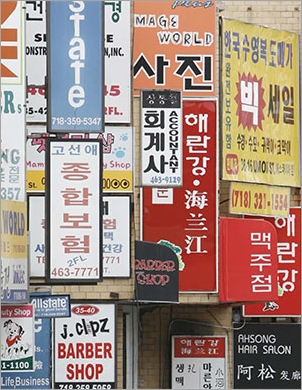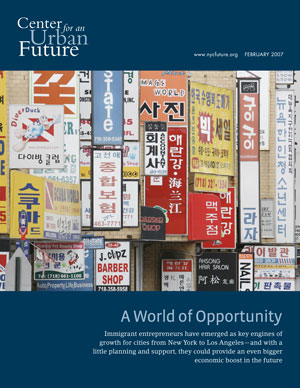With New York City's financial sector expected to lose 65,000 jobs in the current economic downturn, it's more apparent than ever that the city needs to diversify its economy and nurture new sources of job growth. While it's difficult to predict which industries will give the city the economic jolt it needs, it's a good bet that immigrant entrepreneurs will provide a key spark to the city's recovery.
Immigrants have a long and storied history of starting businesses in New York. But their contributions have grown in the past decade or two, thanks to a nearly unprecedented wave of new immigration to the city. During that period, immigrant entrepreneurs have gone from being a mere footnote in the city's economy to a powerful engine of economic growth. Foreign-born entrepreneurs have been starting a greater share of new businesses than native-born residents, stimulating growth in sectors from food manufacturing to health care. In doing so, they have created loads of new jobs and have transformed once-sleepy neighborhoods into thriving commercial centers.
Nationwide, immigrants are nearly 30 percent more likely to start a business than non-immigrants, according to a November 2008 study by the United States Small Business Administration. Another recent study showed that more than half of start-up technology firms in Silicon Valley were founded by immigrants over the last decade. My own research for the Center for an Urban Future reveals that immigrants drove all of the growth in New York City's self-employed population between 1990 and 2000: the number of foreign-born individuals who were self-employed increased by 64,001 (a 53 percent jump) while the number of native-born people who were self-employed decreased by 15,657 (a 7 percent decline).
The Center's 2007 study also found that neighborhoods across the city in which many, if not most, businesses are immigrant-owned witnessed an explosion of new enterprises over the past decade that far surpassed the rate of business creation citywide. Between 1994 and 2004, the number of businesses citywide increased by less than 10 percent, while the number of businesses grew by 55 percent in Flushing, Queens; 47 percent in Sunset Park, Brooklyn; 34 percent in Sheepshead Bay-Brighton Beach, Brooklyn; 25 percent in Elmhurst, Queens; 18 percent in Manhattan's Washington Heights neighborhood, and 14 percent in Jackson Heights, Queens.
Job growth in immigrant-dominated communities also far outpaced overall employment gains. Between 1994 and 2004, overall employment in the city grew by just 7 percent, but rose by 34 percent in Washington Heights, 28 percent in Jackson Heights, 23 percent in Sunset Park, 13 percent in Sheepshead Bay-Brighton Beach, 12 percent in Flushing and 10 percent in Elmhurst.
While immigrant-run companies have already become extraordinary catalysts for economic growth in the five boroughs, they could become even more integral to New York City's economy in the future—and pivotal to resuscitating the city's faltering economy. After all, foreign-born individuals now make up 37 percent of the city's population and are expected to continue to drive much of the city's future population growth. This alone suggests that they will be an increasingly important economic force. At the same time, local economic development officials have barely begun to unlock the full potential of the city's immigrant entrepreneurs. The contributions made by immigrant-run firms, while immense, have occurred with virtually no support from city policymakers and despite the fact that immigrants often face enormous obstacles to starting and growing businesses here. With just a little support, this could be a much more potent source of future growth.
There is reason to believe that New York is not reaching its potential with immigrant-owned businesses. Only a relatively small number of immigrants who own restaurants or other retail businesses have expanded into larger space or opened stores in additional locations. Most vendors never give up their pushcart in favor of becoming a store owner; few businesses that make unique ethnic products have attempted to export to other states where recent immigration patterns have created a market for those goods; and large numbers of immigrant-run firms in New York remain narrowly focused on serving their own ethnic community rather than pursuing greater ambitions in larger markets.
There is also evidence that fewer immigrant- and minority-owned businesses in New York City grow to the next level, as compared to their counterparts in other cities. Of the 15 American cities that have the most Hispanic-owned businesses, New York has the lowest average receipts per establishment. The average Hispanic-owned company in the five boroughs earned just 37 percent as much as a Hispanic-owned business in Houston, 40 percent of the average in Chicago and 42 percent of the average in Miami. Similarly, New York City's Asian-owned businesses took in a smaller amount of receipts, on average, than their counterparts in 13 of the 15 cities with the most Asian-owned businesses. The average Asian-owned company in New York City earned 48 percent as much as a similar establishment in Los Angeles, 57 percent of one in Houston and 71 percent of one in San Francisco.
While immigrant-run businesses in New York City may be less likely to grow than their counterparts in other cities, many foreign-born entrepreneurs in the five boroughs struggle simply to survive. Some go bankrupt after a short existence and others toil in an endless struggle to stay afloat. Many are tripped up by the same factors that hamstring other small businesses in New York, from the high cost of commercial real estate and insurance to the city's overzealous regulatory enforcement agents. Others find it difficult to succeed simply due to intense competition or because their business model isn't sustainable.
But immigrants also encounter a long list of problems unknown to most native-born entrepreneurs—such as unfamiliarity with how business is done in this country, lack of awareness about local regulations, limited financial literacy and, often, little or no credit history. Language barriers add another element of difficulty for numerous immigrant entrepreneurs. Unable to communicate effectively, immigrant entrepreneurs are less likely to attempt to sell goods and services in markets beyond their own ethnic communities, or to seek assistance from established small business assistance providers. Without such help, many immigrant business owners take bad advice from friends, family or accountants, and make costly mistakes. Others turn to professionals who speak their language but who take advantage of them.
Harnessing the potential of immigrant entrepreneurs will require greater attention and support from city economic development officials and the many nonprofit community organizations, chambers of commerce and business assistance groups that work with small businesses around the five boroughs. These entities should be well positioned to help immigrant entrepreneurs overcome these challenges and develop systems that enable them to grow. Unfortunately, too few of the city's established economic development entities have effectively connected with immigrant populations. Meanwhile, immigrant entrepreneurs remain mostly detached from the city's overall economic development strategy.
Fortunately, there's some cause for optimism. Mayor Michael R. Bloomberg recently unveiled a new set of initiatives designed to support small businesses and promote entrepreneurship. Among them was a plan to create a loan fund that might help microfinance organizations increase the number of loans they make to immigrant entrepreneurs.
Yet, much more could be done. The city's Department of Small Business Services and the New York City Economic Development Corporation should develop a new framework for providing business services to immigrant communities. Right now, too few of the programs overseen by the business services agency are reaching immigrant entrepreneurs.
Both entities should also partner more with local organizations that have credibility in immigrant communities. Any plan to provide business services to immigrant entrepreneurs must start with the understanding that countless numbers of legal immigrants will never seek assistance from a government-run center—and that many won't set foot into a nonprofit organization they don't trust.
As part of this, city and state officials should expand their support for microenterprise organizations. These entities—from ACCION New York and Seedco to the Business Outreach Center Network—already have the expertise to support immigrant entrepreneurs but often lack the capacity to serve additional clients.
Finally, city economic development officials should take new steps to ensure that more of the city's immigrant entrepreneurs expand into larger businesses. One option is to help local immigrant—run businesses export their products beyond the five boroughs. A major opportunity lies with the scores of businesses throughout the five boroughs that manufacture unique ethnic products, import foreign goods for distribution, or provide specialized services to immigrant communities. Many of these companies could easily expand their operations—and create new jobs�by exporting their goods and services to other parts of the country that have emerging immigrant populations but few ethnic businesses of their own. With minimal support, some of the city's small immigrant-run firms might become the next Goya Foods or Golden Krust.





